Wetland Diary 18 October 2006
Previous Entry | Wetland Index | Next Entry
This was one of my shortest and most exciting trips to the Wetland Centre. I was only there about ninety minutes, but the late October sunshine was to bring out some surprises.
I arrived at about 11:30, and headed towards the eastern side of the reserve, stopping in the pond area, where a class of school children seemed to be enjoying themselves learning about wetlands. The noise didn't seem to faze the young Marsh Frogs (Rana ridibunda), which had climbed up on to some flattened reeds to enjoy the autumn sunshine.
In the Dulverton Hide I settled down down with my camera and binoculars. There were quite a few Shovelers (Anas clypeata) on the water, and some of the drakes were in fresh winter plumage that glowed in the sun. Sadly, even with equivalent of 500 mm of lens at my disposal, I still couldn't get a close shot. The Wetland Centre is an important site for the Shoveler, with about 1% of the European population wintering at the reserve. Hawker dragonflies were still active, and flying past the front of the hide.
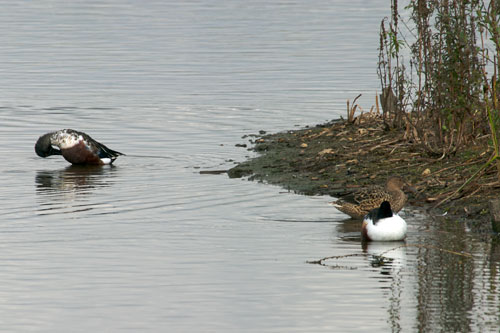
Shoveler Ducks (Anas clypeata).
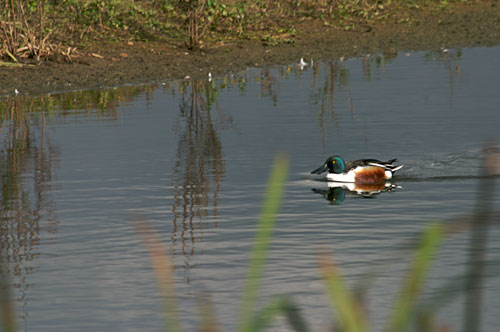
Shoveler (Anas clypeata) drake in winter plumage.
Farther out on the main lake, a group of six Cormorants (Phalacrocorax carbo) were diving for fish. In the photo below, the front four birds have just dived: you can see the ripples in front of the two remaining birds. Cormorants are present all year at the Wetland Centre, and can often be seen standing with their wings outstretched to dry. The birds in the background of the cormorant photograph are Carrion Crows (Corvus corone corone), which seemed to be particularly numerous on this trip.
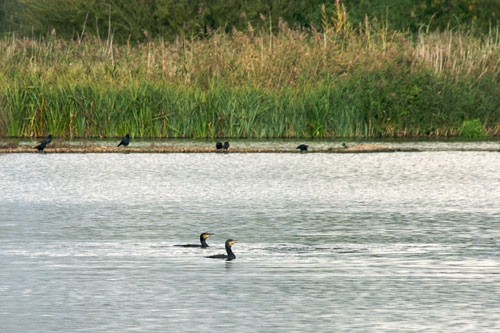
Cormorants (Phalacrocorax carbo) diving for fish in the Main Lake.
In the hide I overheard people talking outside, and the word 'lizard' stood out, but didn't think much of it. When I went outside I discovered a group of people with very large lenses trying to photograph small Viviparous Lizards (Zootoca vivipara) (also known as the Common Lizard), which were sunning themselves on the wooden structure around the hide. London doesn't seem the sort of place you'd find lizards, but they were introduced to the site, and appear to be doing well if the three young ones here were anything to go by.

Viviparous Lizard (Zootoca vivipara).
Thankfully I had brought my macro lens with me (unlike the other people, who were struggling to use enormous telephoto lenses), and was able to get quite close to one of the lizards, which didn't seem at all alarmed. Sadly the depth of field is a little lacking, so the focus is soft on the body, but you can still see the beautiful scale pattern. Having never seen any reptiles at the Wetland Centre (or in London at all, for that matter) it was a treat to find three sitting there in the open.

Close up of Viviparous Lizard (Zootoca vivipara).

Viviparous Lizard (Zootoca vivipara) in the sun.
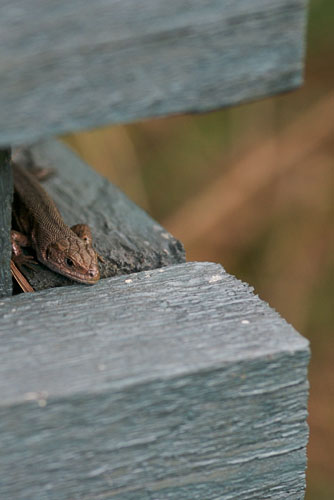
Small Viviparous Lizard (Zootoca vivipara) ventures out.
On a trip in August I had seen a Wasp Spider (Argiope bruennichi) near the Peacock Tower. There weren't any of the spiders about, but someone pointed out to me several of the spider egg cocoons. The Wasp Spider has done very well in recent years, principally due to mild winters, and it looks like there will be plenty of spider hatchlings in the spring, if the weather remains temperate.

Wasp Spider (Argiope bruennichi) egg cocoon.
One of the people who had been photographing the lizards saw a grass hopper on the wooden fence, and moved a bit of grass out of the way photograph it better, only to reveal a tiny (approx. 2.5 cm including tail) Smooth Newt (Lissotriton vulgaris). A first newt for me at the Wetland Centre, and the macro lens once again proved its worth.
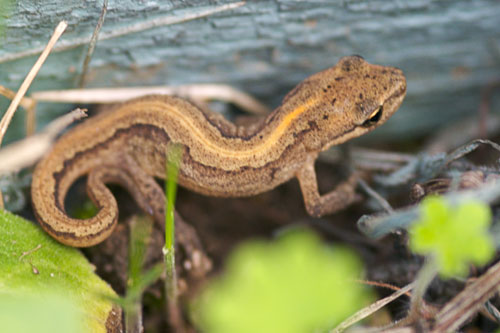
Tiny Smooth Newt (Lissotriton vulgaris).
Finally, I was experimenting with the focusing on the macro, when a fly landed on the edge of the hide and I took the opportunity to photograph it. I have no idea what species it is (the Internet seems to be lacking guides to identifying flies), but you can see the pads on its feet, which gives it a firm grip, and the red eyes are striking.

Unidentified fly species.
It was only one o'clock, but time to leave in search of lunch, and I couldn't see how my first sighting of lizards and a newt in London could be topped.
I won't have a chance to return to the Wetland Centre until mid-November, by which time the newts and lizards will be tucked away under logs hibernating. However, more wildfowl will have arrived, and I should get a chance to photograph a greater variety of birds. Until then, thank you for reading, and I hope you get a chance to visit the Wetland Centre yourself.
Previous Entry | Wetland Index | Next Entry